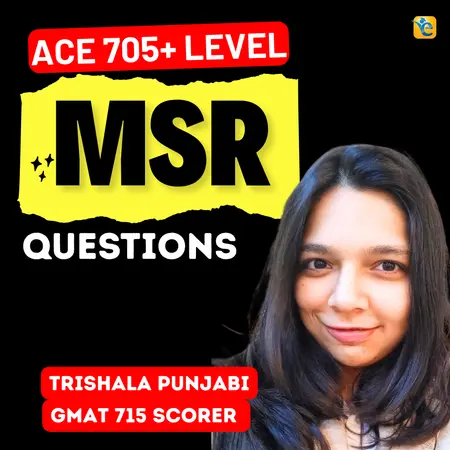Events & Promotions
|
|

GMAT Club Daily Prep
Thank you for using the timer - this advanced tool can estimate your performance and suggest more practice questions. We have subscribed you to Daily Prep Questions via email.
Customized
for You
Track
Your Progress
Practice
Pays
Not interested in getting valuable practice questions and articles delivered to your email? No problem, unsubscribe here.
- Nov 22
11:00 AM IST
-01:00 PM IST
Do RC/MSR passages scare you? e-GMAT is conducting a masterclass to help you learn – Learn effective reading strategies Tackle difficult RC & MSR with confidence Excel in timed test environment - Nov 23
11:00 AM IST
-01:00 PM IST
Attend this free GMAT Algebra Webinar and learn how to master the most challenging Inequalities and Absolute Value problems with ease. - Nov 25
10:00 AM EST
-11:00 AM EST
Prefer video-based learning? The Target Test Prep OnDemand course is a one-of-a-kind video masterclass featuring 400 hours of lecture-style teaching by Scott Woodbury-Stewart, founder of Target Test Prep and one of the most accomplished GMAT instructors.
B
Be sure to select an answer first to save it in the Error Log before revealing the correct answer (OA)!
Difficulty:
 55%
(hard)
55%
(hard)
Question Stats:
60% (02:02) correct 40%
(02:28)
wrong
40%
(02:28)
wrong  based on 2246
sessions
based on 2246
sessions
History
Date
Time
Result
Not Attempted Yet
In the figure above, if MNOP is a trapezoid and NOPR is a parallelogram, what is the area of triangular region MNR?
(1) The area of NOPR is 30
(2) The area of the shaded region is 5
Attachment:
Capture.JPG [ 12.08 KiB | Viewed 151065 times ]
Kudos
Bookmarks
roygush
Solution:
Since NOPR is a parallelogram, angle OPQ and angle NRM are equal in measure. Furthermore, since triangle MNR is isosceles, the height drawn from vertex N to base MR divides the triangle into two congruent right triangles and each of these right triangles will have the same area as triangle OPQ. Therefore, if we know the area of triangle OPQ, then we can determine the area of triangle MNR.
Statement One Only:
The area of NOPR is 30.
Knowing the area of the parallelogram doesn’t give us enough information to determine the area of triangle MNR. Statement one alone is not sufficient.
Statement Two Only:
The area of the shaded region is 5.
The area of the shaded region is the area of triangle OPQ. Therefore, the area triangle MNR is twice as much, or 10. Statement two alone is sufficient.
Answer: B
Kudos
Bookmarks
- Shape NOPR is a parallelogram so that means lines NR and OP are parallel.
- If those lines are parallel, then angle R and angle P are equal. So angle P = x.
- If angle R and angle P are equal then triangle QOP is half of triangle MNR, because triangle MNR base angles are both x.
- You can imagine a line straight down the middle of triangle MNR to create a perpendicular angle, and since the two base angles are both x then triangle MNR is basically just two of triangle QOP.
1. Not sufficient because have no base or height information.
2. Sufficient because we know triangle QOP is half or triangle MNR. Since triangle QOP is area 5, then triangle MNR must be area 10.
- If those lines are parallel, then angle R and angle P are equal. So angle P = x.
- If angle R and angle P are equal then triangle QOP is half of triangle MNR, because triangle MNR base angles are both x.
- You can imagine a line straight down the middle of triangle MNR to create a perpendicular angle, and since the two base angles are both x then triangle MNR is basically just two of triangle QOP.
1. Not sufficient because have no base or height information.
2. Sufficient because we know triangle QOP is half or triangle MNR. Since triangle QOP is area 5, then triangle MNR must be area 10.









